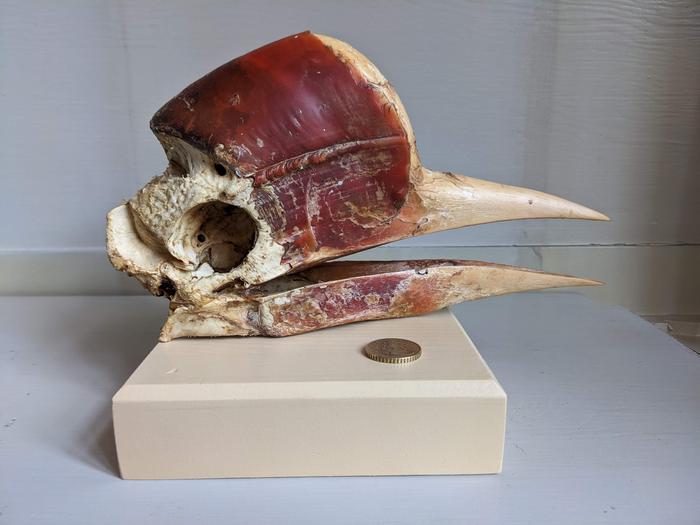New research reveals how the surprising internal anatomy of the helmeted hornbill’s casque allows it to withstand damage during aerial jousting battles with rivals. Researchers hope that this new understanding can help to conserve this critically endangered species, as well as provide new insights into developing impact-resistant bio-mimetic materials.

Credit: Mason Dean
New research reveals how the surprising internal anatomy of the helmeted hornbill’s casque allows it to withstand damage during aerial jousting battles with rivals. Researchers hope that this new understanding can help to conserve this critically endangered species, as well as provide new insights into developing impact-resistant bio-mimetic materials.
“When I started in Hong Kong, I visited City University of Hong Kong (HKU)’s conservation forensics group to chat about their research and they introduced me to this amazing bird, to its bizarre cranial anatomy, and to the threats posed to the species by the illegal wildlife trade,” says Dr Mason Dean, an Associate Professor of Comparative Anatomy at HKU.
The helmeted hornbill (Rhinoplax vigil) is prized in the illegal wildlife trade for its bulbous “casque”, a helmet-like protrusion on the front of its skull. While casques are a shared ornamentation amongst hornbills, they seem to play different roles for different species. In particular, whereas the casques of most species are hollow, that of the helmeted hornbill is fronted by a thick keratin layer (“hornbill ivory”) and packed with an exceptionally dense network of bone.
“As I learned more about this species, I discovered a cross-section of a dried skull in a museum, revealing a shocking trainwreck of trabeculae in the casque,” says Dr Dean. “When I heard that individuals are known to ram their casques together in mid-air displays, I just had to know more about the functional morphology.”
Trabeculae (inter-connected struts inside vertebrate bone) are one way that bones provide high strength and resistance to buckling, in the places where bones need it most. “Understanding hornbill anatomy and how it allows for this jousting behaviour can therefore give us clues about this elusive animal’s ecology and fundamental aspects of its life history and health,” says Dr Dean.
“Since hornbill functional anatomy is virtually unexplored, our findings will ideally also give new perspectives on the bio-inspired design of high-performing composites for tolerating damage from repeated collisions,” says Dr Dean. “We’re especially excited about the idea that helmeted hornbill could be a model for lightweight impact-resistant materials, as this could give solutions for where management of collision is vital, from helmets to vehicles and aerospace rover wheels.”
Dr Dean and his team used microCT to look inside of the casque’s different structures. “We have been focused on understanding the hierarchical architectures of the skull, uniting biology, materials science and engineering techniques,” he says. “We have enough samples that we can compare males and females, with some specimens that still have joint flexibility, and some where the rhamphotheca (the keratin sheath on the casque and mandible) can slide off.”
“Once we started the project a lot of really lovely hornbill enthusiasts came out of the woodwork to help,” says Dr Dean. “We’ve been able to get a detailed and quantitative picture of how the casque is constructed, how the bone interacts with the keratin, and the intricate latticework of bone trabeculae supporting the skull’s impact surface.”
Dr Dean and his team found that the hornbill’s trabeculae were on average as thick or thicker than those in an elephant’s femur, despite belonging to a much smaller animal – contrary to a common trend of trabeculae scaling with animal size. “I’ve used microCT to look at a big diversity of animal skeletons, but I have never seen bony trabeculae like the ones we’ve found in the hornbill,” says Dr Dean.
“That massive stand of trabeculae then channels back to the braincase, like a bundle of banyan tree prop roots, converging on a bony platform that’s far more reinforced than in other hornbills and relatives we’ve looked at,” says Dr Dean. “All of these anatomical features start to give a sense of how the skull of the helmeted hornbill is adapted to withstand one of the fastest known biological impacts, where males butt heads in ‘aerial jousting’ at the speed of automobile collisions.”
Due to the illegal wildlife trade, especially in Asia where Dr Dean and his team work, this species is now Critically Endangered on the IUCN Red List of Threatened Species, with much of its illegal trade through Hong Kong bound for Mainland China. “The helmeted hornbill is one of the largest hornbills species in Asia, with the keratin fronting its casque historically a target for the art and antique market for carving into ornamental wildlife products,” says Dr Dean. ““A large number of our skull specimens still contained the bullets that had likely killed the animal.”
“Since the species is elusive and hard to observe in the wild, there is a great need to improve knowledge of its biology, to preserve its habitat, protect dwindling wild populations, and to develop better tools to ID wildlife products,” says Dr Dean. “We hope projects like ours contribute to an understanding of species’ natural history and raise public awareness of the challenges facing biodiversity loss, while also ideally showing scientists that steps toward conservation need not solely come from conservation biologists!”
This research is being presented at the Society for Experimental Biology Annual Conference in Prague on the 2-5th July 2024.




